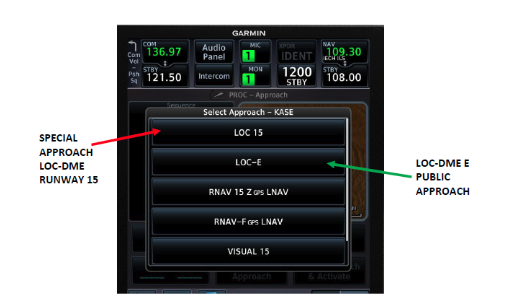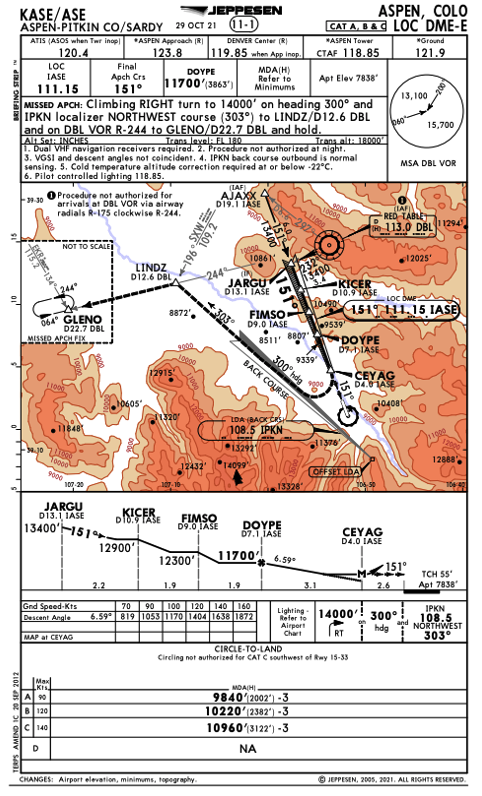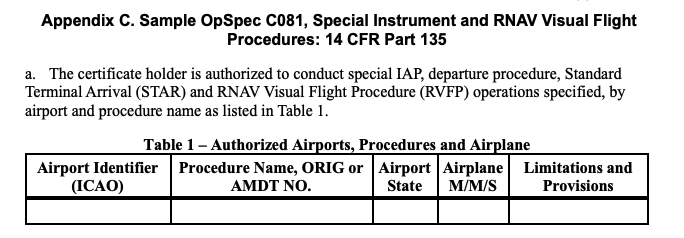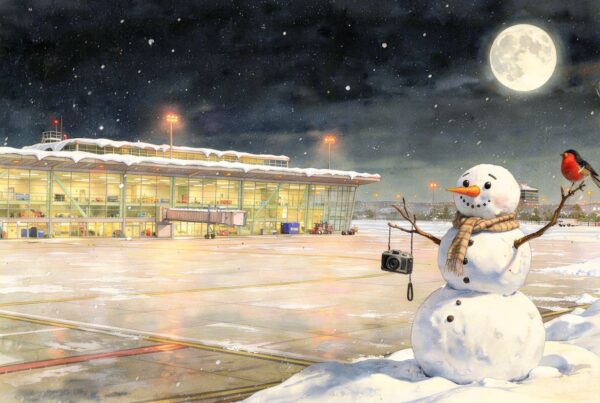Key Points
- Be careful to select and fly the correct LOC approach at KASE/Aspen – there are two. The normal public use one is the ‘LOC-DME-E.’ The second is the ‘SPECIAL LOC-DME RWY 15’ which requires approval to fly.
- Some FMS systems have both in their databases which is causing confusion.
- There are some safety-critical differences between the two so make sure you shoot the right one.
The FAA has put out a new Letter to Airmen with a warning for ops at Aspen.
There are two localiser approaches available which is causing potentially safety-critical confusion.
The primary (public use) approach is the LOC-DME E. The second is the SPECIAL LOC-DME RUNWAY 15 which requires prior approval via an LOA from FAA Flight Standards.
Many FMS systems have both in their database, and it’s not always crystal clear which is the correct one to select:

Typical FMS approach selection – which would you have chosen?
The notice goes on to explain that there are some really important differences between the two which could lead to pilots accidentally busting crossing heights or minimums and losing safe separation from terrain.
As arguably one of the most challenging airports in the US, it’s important to get it right.
What’s the difference?
The first is the minima. If your ride is a CAT C for instance, the standard ‘E’ approach will get you down to 3122’ AGL.
The ‘SPECIAL’ approach gets you lower – up to two grand closer to terra firma. Extra simulator training is required to make this possible. This includes the next big difference – changes to the way missed approaches must be flown.
Some operator-versions of this approach include an ’emergency extraction procedure’ for go-arounds beyond the missed approach point for instance.
…Not unlike an emergency extraction at the dentist, things are going to get white knuckle if you haven’t received the proper training first.

Get the proper training before you attempt an emergency extraction.
And finally, there is the time of day – the publicly available ‘E’ approach cannot be flown at night. In some cases, the special can with the right paperwork.
The standard ‘E’ approach will be advertised and offered by default when the localiser approach is in use. Here’s what it looks like:

The LOA
If you’re seeking an approval to actually use the SPECIAL LOC approach, you’ll need to obtain an OpSpec C081 special authorisation like the one below. This will include Aspen specific training for all operating crew.

If you’d like to know more about this process, the NBAA has published this doc which is worth a read.
Have More Info?
We’re always on the lookout for intel from pilots out there. If you’re familiar with KASE and would like to add to this article, please get in touch with us on team@ops.group. We’d love to hear from you.
More reading:
- Latest: Milan targets business jets with 650% rate increase
- Latest: 2025 Flight Ops Changes: The Big Ones
- Latest: More face scans at the US border for BizAv flights
- Safe Airspace: Risk Database
- Weekly Ops Bulletin: Subscribe
- Membership plans: Why join OPSGROUP?











 Get the famous weekly
Get the famous weekly 






Funny, as I flew into KASE the day before receiving this email. Sure enough, I saw the two LOC approaches at KASE on my G1000, but did not see the second approach on my plates with ForeFlight. I did not find a NOTAM for the second LOC approach, nor any supplemental information. Thankfully it was CAVU and was assigned the Roaring Fork Visual Runway 15.